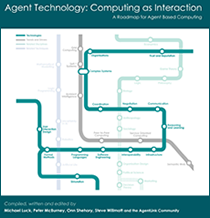In its brief history, computer science has enjoyed several different metaphors for the notion of computation. From the time of Charles Babbage in the nineteenth century until the mid-1960s, most people thought of computation as calculation, or the manipulation of numbers. Indeed, the English word “computer” was originally used to describe a person undertaking arithmetical calculations. With widespread digital storage and processing of non-numerical information from the 1960s onwards, computation was re-conceptualized more generally as information processing, or the manipulation of numerical-, text-, audio- or video-data. This metaphor is probably still the prevailing view among people who are not computer scientists. From the late 1970s, with the development of various forms of machine intelligence, such as expert systems, a yet more general metaphor of computation as cognition, or the manipulation of ideas, became widespread, at least among computer scientists. The fruits of this metaphor have been realized, for example, in the advanced artificial intelligence technologies which have now been a standard part of desktop computer operating systems since the mid-1990s. Windows95, for example, included a Bayesnet for automated diagnosis of printer faults.
With the growth of the Internet and the Web over the last two decades, we have reached a position where a new metaphor for computation is required: computation as interaction, or the joint manipulation of ideas and actions. In this metaphor, computation is something which happens by and through the communications which computational entities have with one another. Cognition and intelligent behaviour is not something which a computer does on its own, or not merely that, but is something which arises through its interactions with other intelligent computers to which is connected. The network is the computer, in SUN’s famous phrase. This viewpoint is a radical reconceptualization of the notion of computation.

In this new metaphor, computation is an activity which is inherently social, rather than solitary, and this view leads to a new ways of conceiving, designing, developing and managing computational systems. One example of the influence of this viewpoint, is the model of software as a service, for example in Service Oriented Architectures. In this model, applications are no longer “compiled together” in order to function on one machine (single user applications), or distributed applications managed by a single organization (such as most of today’s Intranet applications), but instead are societies of components:
- These components are viewed as providing services to one another rather than being compiled together. They may not all have been designed together or even by the same software development team; they may be created, operate and de-commissioned according to different timescales; they may enter and leave different societies at different times and for different reasons; and they may form coalitions or virtual organizations with one another to achieve particular temporary objectives. Examples are automated procurement systems comprising all the companies connected along a supply chain, or service creation and service delivery platforms for dynamic provision of value-added telecommunications services.
- The components and their services may be owned and managed by different organizations, and thus have access to different information sources, have different objectives, have conflicting preferences, and be subject to different policies or regulations regarding information collection, storage and dissemination. Health care management systems spanning multiple hospitals or automated resource allocation systems, such as Grid systems, are examples here.
- The components are not necessarily activated by human users but may also carry out actions in an automated and co-ordinated manner when certain conditions hold true. These pre-conditions may themselves be distributed across components, so that action by one component requires prior co-ordination and agreement with other components. Simple multi-party database commit protocols are examples of this, but significantly more complex co-ordination and negotiation protocols have been studied and deployed, for example in utility computing systems and in ad hoc wireless networks.
- Intelligent, automated components may even undertake self-assembly of software and systems, to enable adaptation or response to changing external or internal circumstances. An example is the creation of on-the-fly coalitions in automated supply-chain systems in order to exploit dynamic commercial opportunities. Such systems resemble those of the natural world and human societies much more than they do the example arithmetical calculations programs typically taught in Fortran classes, and so ideas from biology, ecology, statistical physics, sociology, and economics play an increasingly important role in computer science.
How should we exploit this new metaphor of computation as a social activity, as interaction between intelligent and independent entities, adapting and co-evolving with one another? The answer, many people believe, lies with agent technologies. An agent is a computer programme capable of flexible and autonomous action in a dynamic environment, usually an environment containing other agents. In this abstraction, we have software entities called agents, encapsulated, autonomous and intelligent, and we have demarcated the society in which they operate, a multi-agent system. Agent-based computing concerns the theoretical and practical working through of the details of this simple two-level abstraction.
Reference:
Text edited slightly from the Executive Summary of:
M. Luck, P. McBurney, S. Willmott and O. Shehory [2005]: The AgentLink III Agent Technology Roadmap. AgentLink III, the European Co-ordination Action for Agent-Based Computing, Southampton, UK.